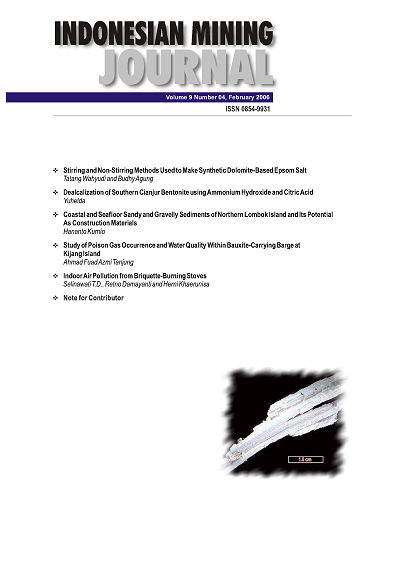COASTAL AND SEAFLOOR SANDY AND GRAVELLY SEDIMENTS OF NORTHERN LOMBOK ISLAND AND ITS POTENTIAL AS CONSTRUCTION MATERIALS
DOI:
https://doi.org/10.30556/imj.Vol9.No1.2006.657Keywords:
COASTAL AND SEAFLOOR SANDY AND GRAVELLY SEDIMENTS OF NORTHERN LOMBOK ISLAND AND ITS POTENTIAL AS CONSTRUCTION MATERIALSAbstract
Based on grain size analyses as well as microscopic and megascopic observations, coastal and seafloor sediments of northern Lombok Island are subdivided into 6 units : slightly gravely sand, slightly gravelly muddy sand, sand, gravelly sand, silty sand and slightly gravelly sandy mud. The slightly gravelly sand, sand and gravelly sand are of interest for its potentiality for construction material due to its widespread distribution and its low content of muddy and silty materials. Some offshore sediments are possibly landslide in origin as observed from factors such as steep seabottom slope of northern Lombok, graphic presentations of bimodal - polymodal histogram presentations as well as poorly sorted character of frequency curve diagrams and evidence from analog seismic record which demonstrates slumping of seabottom sediments.References
Andi Mangga, S., drr., 1994. Geologi Lembar Lombok, Nusatenggara, Pusat Penelitian dan Pengembangan Geologi, Indonesia (In Indo- nesian).
Buchanan, J.B. 1984. Sediment Analysis In: Holme, N.A & McIntyre, A. Methods for the study of Marine Benthos. Blackwell Scientific Publications, London. pp. 41-65.
Folk, R.L., 1980. Petrology of Sedimentary Rocks, Hemphill Publishing Company, Austin, Texas.
Kurnio, H. and Setiady, D., 2000. Lombok coastal and offshore aggregates and its possibilities for local usage. Indonesian Mining Journal, Vol. 6, No. 3, October 2000, pp.12-19.
Kurnio, H. and Surachman, M., 2005. Coastal cha- racteristics of Northern Lombok Island con- trolled by cone-shaped formations of the
Rinjani Volcano. Bulletin of Marine Geology, Vol. 20, No. 1, November 2005, pp.15-28.
Suratno, N., 1994. Peta Geologi dan Potensi Bahan Galian Nusa Tenggara Barat, Skala 1
: 250.000, Kanwil Departemen Pertambangan Energi Propinsi Nusa Tenggara Barat (In In- donesian).
Tim Lombok Utara, 2000. Laporan. Penyelidikan Geologi Wilayah Pantai Perairan Lombok Utara Propinsi Nusatenggara Barat. Proyek Peny. Geologi Wil. Pantai T..A. 1999/2000. PPPGL, unpubl (In Indonesian).
http://faculty.uaeu.ac.ae/fhowari/images/fares/pre- s e n t a t i o n s - classes%5Cmarine%5Csediment.htm.
http://gpc.edu/janderso/historic/labman/ sievean.htm. Anderson, J.R., 2006. Sand Sieve Analyses. Department of Geology, Georgia Perimeter College. Dunwoody, GA 30038.
Downloads
Issue
Section
License
Indonesian Mining Journal provides immediate open access to its content on the principle that making research freely available to the public to supports a greater global exchange of knowledge.

This work is licensed under a Creative Commons Attribution-NonCommercial 4.0 International License.













